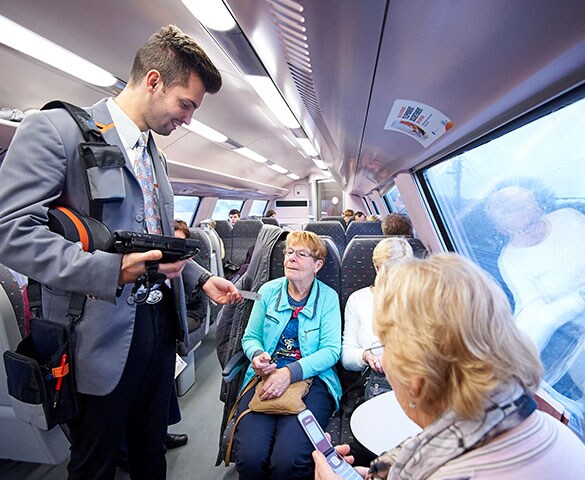The challenge
In direct daily contact with customers, train conductors play an important role in supporting NMBS/SNCB’s business and reputation. For the last 10 years, they’ve been serving customers on Belgium’s trains using the so-called IBIS device that, weighing in at 1.15 kg, has taken its toll on conductors’ wrists and shoulders.
One of the heaviest components of the IBIS was the ticket printer that conductors were required to carry at all times for customers paying for travel on the train itself. The IBIS device was also showing signs of aging. Despite there being only 3,000 in use, and a further 1,000 in stock for use as replacements, NMBS/SNCB was dealing with more than 7,000 repairs a year, at substantial cost.
Time for a new solution: a lighter, more ergonomic system that is at the same time extremely robust. And with a long-lasting battery, but not too heavy. One that would improve communication with customers and provide real-time information about possible disruption to service. That could cater to the needs of GSM-R (Global System for Mobile Communications – Railway), an international wireless communications standard for railway communication that enables higher train speeds and traffic density with a high level of safety.
NMBS/SNCB’s new solution also had to allow for mobile ticketing and the potential addition of new features, making it virtually future-proof. The operator needed the right partners to support its journey in identifying, developing and introducing a new solution.
The solution
From strategy through execution
With proven experience in the rail sector and the field of mobile ticketing, PwC proved to be that partner, together with Panasonic that developed the hardware for the new solution. Involved from the very beginning and taking the role of project management office, PwC was involved in every step; from strategy to execution. Although our role went far beyond that of a traditional project management office to include planning, administration, budgeting, communications to staff and the board of directors, and more, to the delight of NMBS/SNCB.
Initially, we shadowed NMBS/SNCB train conductors to gain a complete understanding of their job and the issues they faced. A concept study listed issues and created design flow for the new solution. The focus was very much on transforming the work of the train conductor as a key representative of the operator’s business.
We supported the RFIP process, helping define and set detailed requirements and criteria for the solution. Requirements were set based on research undertaken with more than 250 train conductors via roadshows and a questionnaire. Security and privacy were to be built in by design. We monitored and managed the tender process to make sure it adhered to requirements and legal expectations, and to prevent procurement issues and later dispute with selected suppliers.

©NMBS

©NMBS
Supporting an adaptable standard solution
The ITRIS solution comprises a main terminal together with a handheld device. It was chosen for its screen quality, robustness and unique, long-life battery. It fulfils NMBS/SNCB’s preference for an out-of-the box solution, rather than a custom-made device, to allow for faster deployment and the easier addition of new features.
Although a standard solution, the main terminal offers the possibility to extend functionality via SAM-slots that allow new features to be added securely with encrypted data, without adding weight to the device. One such feature is the essential GSM-R which could be quickly integrated. The SAM-slots mean future additions can also be rapidly made.
The battery was designed by Panasonic specifically for the project to offer the required long life while maintain its weight below the 150g threshold. Together, the device including battery and all features weighs in at just 850g.
Continual communication is key
Regular status meetings were held throughout the project to make sure that all parties adhered to the plan and roles and responsibilities were clear. When issues arose, they were dealt with as a team – NMBS/SNCB, PwC and Panasonic – with everyone kept in the loop to find solutions as quickly as possible.
PwC’s project management capabilities proved invaluable as did our change management experience. While the former IBIS solution was frustrating users, learning a new system may also prove to be a challenge. We were involved in briefing pilot testers and communicating about the project from the beginning to help create a positive atmosphere for change. Feedback was acquired in the field and acted on.

©NMBS
"PwC were able to manage the large number of stakeholders involved in the project. It was very much thanks to their efforts that we were able to keep the project on track and get to such a high-quality solution within the time frame."
Taking daring decisions
One of the biggest and most daring challenges was the decision to omit the printer from the new solution. Based on our mobile ticketing knowledge and expertise, we were able to make the business case for why it was feasible. The lack of printer not only makes ITRIS significantly lighter, but assures its readiness for the future of paperless ticket travel. The satellite scans and validates smart travel cards and validates home printed tickets.
For passengers looking to pay for travel once aboard the train a disposable smart card is issued. The new equipment offers good quality NFC (near field communication) and uses RFID (radio frequency identification) tickets instead of paper ones. Passengers requiring a paper ticket can obtain one from any ticket vending machine, from a ticket office or via the Internet.
Another significant challenge faced during the project was linking the new device with the operator’s 32 back-end systems - all of which were totally different and in different parts of their life cycle –, particularly, the financial end to enable ITRIS to sell tickets.
As well as facilitating payment for travel, the new equipment offers details of the conductor’s work schedule and real-time information about train travel, changes and delays. Uploaded digitally, train conductors can consult their schedule easily at any time and required changes can be made and communicated easily. Likewise, platform information and details of delays is automatically uploaded and train conductors can offers passengers correct information in an easy-to-read format via the tablet when requested, even when the device is offline.
The introduction of the ITRIS solution has been accompanied by substantial training for users.

©NMBS
Result
Fit for the digital world, the new ITRIS solution is entirely revolutionising the way NMBS SNCB’s train conductors interact with customers. It offers a substantial boost to the service NMBS/SNCB offers in terms of information and paying for travel. And it offers conductors a much more efficient and ergonomic tool with which to carry out day-to-day tasks. ITRIS has set a new standard in the rail industry that other operators are looking at with envy. No other operator has such a total package that also allows for future upgrades.
Future iterations of the device will help enhance features. For example, in upcoming releases, it’s expected that train information can be sent directly to a passenger’s smart phone, all the necessary privacy and security constraints built in. The ability for a passenger’s journey to be added to their travel card, if they have one, and a bank card app are also foreseen.









